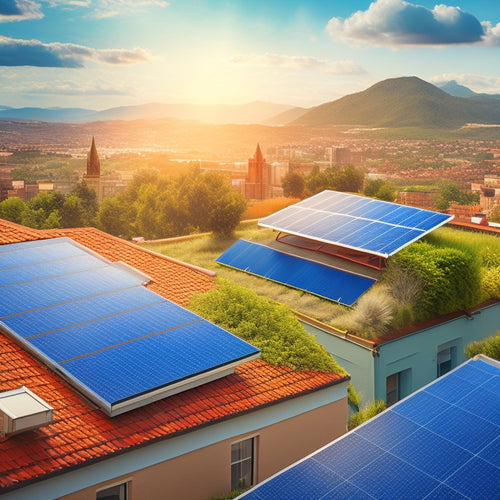
Choosing Between Vertical and Horizontal Geothermal: A Guide
Share
You're evaluating the pros and cons of vertical and horizontal geothermal systems for your heating and cooling needs. Both options employ natural heat from the earth, offering a sustainable alternative to traditional methods. Vertical systems excel in properties with limited land, providing flexibility in determining energy needs, while horizontal systems are more cost-effective for larger installations. When choosing, consider factors like land use, installation costs, and system performance. You'll also want to examine maintenance requirements, climate suitability, and system efficiency. As you maneuver through these considerations, you'll uncover the perfect fit for your unique situation, and a clear path forward will emerge.
Key Takeaways
- Vertical geothermal systems are suitable for properties with limited land availability, offering flexibility in assessing energy needs.
- Horizontal geothermal systems have lower installation costs for larger systems and are ideal for areas with high thermal conductivity soil.
- System performance and efficiency are influenced by factors like heat transfer, system sizing, seasonal performance, and technology advancements.
- Maintenance requirements for geothermal systems include seasonal upkeep, annual inspections, and emergency repairs, with costs varying depending on the system type.
- Climate suitability considerations, such as temperature extremes, soil conditions, moisture levels, and seasonal changes, play a crucial role in choosing between vertical and horizontal geothermal systems.
Understanding Geothermal System Basics
As you consider investing in a geothermal system, it's essential to grasp the fundamental principles of how these systems operate.
Geothermal energy utilizes the natural heat of the earth to provide heating, cooling, and hot water. This is achieved through a network of underground pipes that circulate a mixture of water and antifreeze.
The earth's thermal conductivity allows it to absorb and release heat, which is then transferred to your building. The system's efficiency relies on the temperature difference between the earth and your desired indoor climate.
Much like electric vehicles reducing environmental impact, geothermal systems offer a sustainable alternative to traditional heating and cooling methods.
Vertical Loop System Advantages
You've grasped the fundamental principles of geothermal systems, now it's time to investigate the advantages of vertical loop systems.
One significant benefit is their minimal environmental impact. Since the pipes are buried underground, they don't disrupt the surrounding ecosystem, making them an attractive option for environmentally conscious homeowners.
Another advantage is the relatively short installation timeline. Vertical loop systems can be installed in a matter of days, reducing the overall project duration and minimizing disruptions to your daily routine.
Additionally, vertical loops can be installed in smaller spaces, making them ideal for properties with limited land availability.
Moreover, when considering renewable energy solutions, it's crucial to assess energy needs and infrastructure to guarantee a smooth shift. By doing so, you can facilitate informed decisions and calculate the ROI for solar panels to maximize energy production and reduce fuel use.
This flexibility, combined with their eco-friendly nature, makes vertical loop systems an appealing choice for those seeking a reliable and sustainable heating and cooling solution.
Horizontal Loop System Benefits
While installing a horizontal loop system might require more land area compared to its vertical counterpart, it offers several benefits that make it a viable option for many homeowners.
You'll appreciate the advantages of this system, including:
Renewable energy solutions, such as geothermal energy, are becoming increasingly popular in the transportation sector, with fleet owners adopting sustainable practices to reduce their carbon footprint.
-
Lower installation costs for larger systems: Horizontal loops are often more cost-effective for larger homes or commercial properties.
-
Flexibility in installation techniques: You can choose from various installation methods, such as trenching or boring, to suit your property's unique needs.
-
Reduced environmental impacts: Horizontal loops have a smaller footprint and can be installed in existing terrains, minimizing disruptions to the environment.
- Increased system longevity: With proper installation and maintenance, horizontal loops can last for decades with minimal degradation.
Comparing Installation Costs
Your property's unique characteristics play a significant role in determining the installation costs of a geothermal system. Factors such as soil type, land size, and local regulations influence the cost analysis. You'll need to evaluate financing options, contractor selection, and regional pricing to get the best deal.
| Installation Factor | Vertical | Horizontal |
|---|---|---|
| Drilling costs | Higher | Lower |
| Land requirements | Less | More |
| Installation complexity | Higher | Lower |
| System longevity | Longer | Shorter |
| Equipment choices | More | Fewer |
When choosing between vertical and horizontal geothermal systems, assess the long-term savings and system longevity. While vertical systems may require higher upfront costs, they can provide longer system life and more equipment choices. Horizontal systems, on the other hand, may be more budget-friendly but have shorter system lifespans.
Space and Land Requirements
When considering a geothermal system, you'll need to think about the land use implications and available space constraints.
Vertical systems typically require less land area, making them suitable for smaller plots, while horizontal systems need more space to accommodate the lengthy pipes.
You'll need to assess your property's specifics to determine which system is the best fit.
Land Use Considerations
Land use factors play an essential role in determining the feasibility of a geothermal system, as they directly impact the space and land requirements of the installation.
When evaluating land use, you'll need to take into account the following factors: Incentives for eco-friendly initiatives, such as the California HVIP Rebate Program, can also influence land use decisions, as they promote sustainable practices and reduce emissions.
Additionally, government incentives can encourage the adoption of cleaner technologies, leading to a greener future.
-
Zoning regulations: Make sure that your geothermal system complies with local zoning laws and regulations.
-
Land conservation: Contemplate the environmental impact of your system and how it may affect local ecosystems.
-
Space requirements: Calculate the amount of land needed for the system, including the size of the loop field or well.
- Land availability: Verify that the necessary land is available for the system, considering any potential obstacles or restrictions.
Available Space Constraints
You're likely wondering how much space you'll need for your geothermal system. The available space constraints play a significant role in deciding between vertical and horizontal geothermal systems.
Site accessibility is an essential factor, as it affects the feasibility of drilling or excavating. Terrain impacts also come into play, as you'll need to evaluate the visual and environmental effects of your system.
For instance, solar-powered charging systems can be an efficient solution for reducing carbon footprint, and their space requirements can inform your geothermal system design. Similarly, energy storage systems can enhance grid resiliency and optimize energy usage, which is also relevant to geothermal system planning.
For horizontal systems, you'll need a larger area for the trenches or pipes, whereas vertical systems require less space but may need more extensive drilling equipment.
Evaluating your site's constraints will help you determine which system is most suitable for your needs, ensuring a more efficient and environmentally friendly installation.
System Performance and Efficiency
When evaluating vertical and horizontal geothermal systems, you'll want to contemplate their performance and efficiency metrics.
You'll need to assess heat pump efficiency, system coefficient performance, and energy output ratio to determine which system best meets your needs.
Heat Pump Efficiency
Across various climates and applications, the efficiency of a geothermal heat pump system plays a vital role in determining its overall performance and cost-effectiveness.
As you consider a geothermal system, it's important to understand the factors that impact its heat pump efficiency.
-
Heat transfer: The system's ability to transfer heat between the earth and your building affects its overall efficiency.
-
System sizing: A correctly sized system guarantees ideal energy consumption and reduces environmental impact.
-
Seasonal performance: The system's performance varies with seasonal changes, and understanding these fluctuations is important for ideal installation techniques.
- Technology advancements and financial incentives: Staying updated on the latest technology and available financial incentives can greatly improve the system's efficiency and cost-effectiveness.
System Coefficient Performance
As heat pump efficiency relies on various factors, it's equally important to assess the system's coefficient of performance (COP) to secure ideal system performance and efficiency.
You want to verify your geothermal system operates at its best, after all. The COP measures the ratio of heat energy moved versus the electrical energy consumed. A higher COP indicates better system efficiency.
When evaluating COP, consider factors like system design, installation quality, and maintenance. Look for performance metrics like seasonal COP, which provides a more thorough view of system efficiency.
Energy Output Ratio
In relation to gauging your geothermal system's overall performance, the energy output ratio (EOR) is another essential metric to take into account.
EOR measures the amount of usable energy produced per unit of energy consumed. A higher EOR indicates better energy efficiency and output enhancement.
To give you a clearer understanding, consider the following factors that impact your geothermal system's EOR:
-
System design: A well-designed system with efficient pipe sizing and placement can greatly improve EOR.
-
Fluid temperature: The temperature of the fluid flowing through the system affects EOR, with higher temperatures resulting in better performance.
-
Pump efficiency: The efficiency of the pumps used in the system also plays a significant role in determining EOR.
- Heat exchanger performance: The performance of the heat exchanger, which transfers heat from the fluid to the building, is another important factor influencing EOR.
Maintenance and Repair Needs
How often will you need to perform maintenance tasks on your geothermal system? As a homeowner, you'll want to guarantee your system runs efficiently and effectively. Both vertical and horizontal geothermal systems require routine checks and maintenance schedules to prevent emergency repairs and extend system longevity.
| System Type | Maintenance Frequency | Repair Costs |
|---|---|---|
| Vertical | Quarterly | Higher (deep drilling) |
| Horizontal | Bi-annually | Lower (shallow digging) |
| Both | Seasonal upkeep (filter cleaning, etc.) | Varies (technician training, part replacements) |
| Both | Annual inspections | Moderate (preventive measures) |
| Both | Emergency repairs (as needed) | High (urgent, unplanned repairs) |
Suitability for Different Climates
You've considered the maintenance needs of your geothermal system, now it's time to think about the climate where you'll be installing it. The suitability of your system depends on the specific climate zone you're in, which affects temperature variations, soil conditions, and moisture levels.
These factors impact the system's energy demands, installation feasibility, and environmental impacts.
Here are key climate considerations for your geothermal system:
-
Temperature extremes: Vertical systems perform better in areas with large temperature variations, while horizontal systems are more suitable for areas with moderate temperatures.
-
Soil conditions: Soil with high thermal conductivity is ideal for horizontal systems, while vertical systems can handle poorer soil conditions.
-
Moisture levels: High moisture levels can reduce the efficiency of horizontal systems, making vertical systems a better choice.
- Seasonal changes: Areas with distinct seasonal changes may benefit from vertical systems, which can handle these fluctuations more effectively.
Frequently Asked Questions
Can I Install a Geothermal System in an Existing Building?
You can install a geothermal system in an existing building, but be prepared to overcome geothermal installation challenges, such as modifying the building's infrastructure and footprint, to accommodate the system's unique requirements.
Are Geothermal Systems Compatible With Radiant Floor Heating?
You'll find that geothermal systems are highly compatible with radiant floor heating, offering enhanced radiant efficiency, as they provide a consistent heat source, allowing you to maximize your system's performance and reap the benefits of a harmonious, efficient heating setup.
Do Geothermal Systems Require Special Plumbing or Piping?
As you immerse yourself in the world of geothermal systems, you'll find that they require specialized piping designed to withstand high pressures and temperatures, adding to installation costs, but ensuring low system maintenance and giving you the freedom to utilize earth's energy.
Can Geothermal Systems Be Used for Hot Water Heating?
You can utilize geothermal energy for hot water heating, increasing your home's geothermal efficiency. By integrating a hot water distribution system, you'll enjoy a reliable, eco-friendly, and cost-effective solution, freeing you from traditional heating methods and enhancing your independence.
Are Geothermal Systems Eligible for Government Incentives or Tax Credits?
You're in luck! As you investigate geothermal options, you'll be thrilled to know that you're likely eligible for government incentives and tax credits, sweetening the deal and giving you more freedom to invest in a sustainable future.
Related Posts
-

7 Best EV Battery Health Trackers for Homeowners
You can maximize your electric vehicle's performance and lifespan by leveraging advanced battery health trackers that...
-

Why Choose Solar Composting Toilets for Your Home?
By choosing a solar composting toilet for your home, you'll greatly reduce your environmental impact, slashing your w...
-

What Roofing Materials Best Protect Our Planet?
As you consider the environmental impact of your building, you're likely to find that the roofing material you choose...


